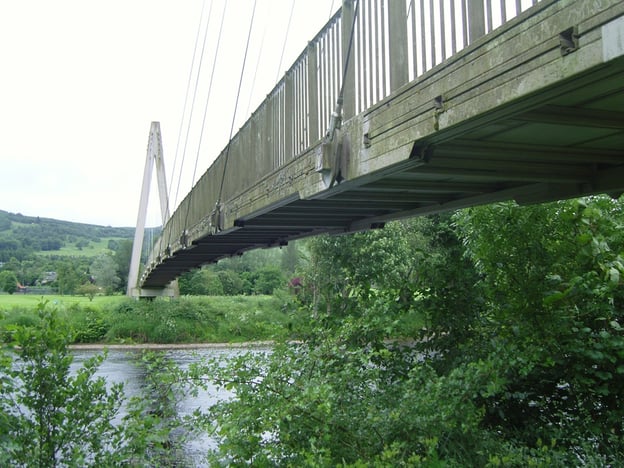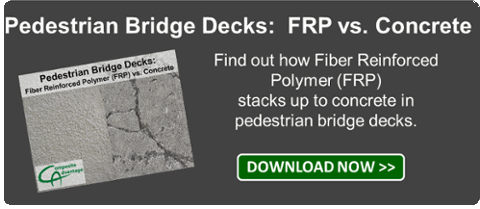
Photo courtesy of the Happy Pontist.
Golfers consider an 18-hole game standard fare these days. But 30 years ago, nine-hole courses like the one at Aberfeldy Golf Club in the Scottish Highlands were common. When the club did decide it was time to add nine more holes across the River Tay, the need for a durable, cost-efficient bridge turned the area into a staging ground for an experiment in advanced materials.
One of the world’s first Fiber Reinforced Polymer (FRP) bridges, Aberfeldy Footbridge, will turn 25 this October, a noteworthy anniversary I first mentioned back in January. Since opening in 1992, the bridge has endured countless spiked golf shoes as well as weather extremes ranging from severe flooding to 140 kph winds. The structure’s longevity also gives us the gift of hindsight, something Dr. Tim Stratford, School of Engineering, University of Edinburgh, capitalized on in 2012.
Stratford used the Aberfeldy Footbridge as a case study for the durability of FRP, or as they say in Scotland, Glassfibre Reinforced Plastics (GRP). His study lets us look through the lens of time at “lessons learned,” which are critical to improving new technology products.
First, a bit of history. In 1992, there wasn’t a lot of data on GRP applications. When GRP was identified as a viable solution for the Aberfeldy Footbridge, Dundee University Professor Bill Harvey became involved. Harvey started the Linksleader Project, also comprised of designer Maunsell Structural Plastics, contractor O'Rourke and several final-year university students. The Project team was tasked with spanning the River Tay - designing and building a solution that could safely carry pedestrians and their gear to the other side.
Their solution, of course, was the Aberfeldy Footbridge. At 113 m long, with a main span of 63 m, the bridge immediately grabbed the title of "longest span composite bridge" in the world. The team chose interlocking GFRP pultruded sections for the 2.23 meter-wide bridge deck and the two 17.5 meter-high towers that anchored 40 cable-stays arranged in two planes. They used Parafil ropes made from Kevlar aramid fiber for the cables, and steel and concrete for the foundation and steel cable connections. The pultrusions and tower legs were bonded together using epoxy. The main deck, side panels and entire span were lowered into place using lightweight equipment. A recycled rubber conveyor belt provided the footbridge’s wear-resistant surface. For more detailed information on the bridge design, read "A Critical Analysis of the Aberfeldy Footbridge, Scotland," by J.M. Skinner.
Back to lessons learned. Remember that Aberfeldy was a demonstration project and one of the first. Now, fast forward 20 years. One finding, according to Stratford, was that the original design didn't account for the extra concentrated load exerted by golf carts or small maintenance tractors. As a result, overloading caused the GFRP deck surface to crack. The footbridge was strengthened in 1997.
Let's examine other lessons learned, then and now.
| Then | Now |
| Cracked deck surface was caused by overloading. | Concentrated wheel loads are now part of almost all pedestrian bridge requirements. Once the bridge exceeds a width of more than 6 feet, someone will need to drive a maintenance or emergency vehicle on it. |
| The footbridge exhibited extensive mold, lichen, algae and moss growth. | Modern resins are inert and do not support the growth or fungus or other organic material. |
| The bridge’s light weight contributed to rolling. The undulation impacted parapet connections, causing a large number to loosen. | Engineers evaluate and account for natural frequency. |
| The handrail’s uprights sustained damage from random golf cart collisions. | Handrail wear is no longer an issue thanks to UV inhibitors in FRP handrails, aluminum railings, stainless steel and galvanized steel. |
| The bridge's wear surface exhibited erosion. | Instead of recycled rubber, our modern bridge surfaces use a quartz aggregate in a methyl methacrylate polymer for greater durability, less roughness and higher elongation than conventional non-slip overlay. |
Aberfeldy Footbridge faces a good cleaning and the eventual replacement of its parapets, handrails and connections, but the span itself has proved structurally sound. Advances in FRP have solved many of the issues uncovered in Stratford’s study.
In summary, pioneering projects like the Aberfeldy Footbridge deserve a nod for contributing to a pool of knowledge that continues to propel FRP forward in a variety of markets. It will be interesting to look back on how the technology has evolved in another 25 years.

